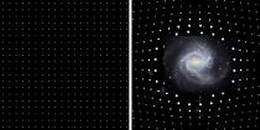Sky survey detects Einstein-predicted cosmic magnification

An international team of scientists associated with the Sloan Digital Sky Survey (SDSS) will report on April 26 the detection of the long-sought "Cosmic Magnification," which is predicted by Einstein's General Theory of Relativity.
Donald Schneider, Penn State professor of astronomy and astrophysics, is one of the authors of the study, which measures how gravity influenced the light produced by a set of 200,000 quasars as it traveled billions of light years through the universe on its way to Earth.
Image: The left panel shows a grid of points representing background quasars. The right panel is the same grid after being "gravitationally lensed" by the cluster of galaxies shown in the center of the panel (the magnitude of the effect is exaggerated to make it apparent by eye). Photo: Joerg Colberg, Ryan Scranton, Robert Lupton, Sloan Digital Sky Survey
"This is a major result because it tests and confirms Einstein's theory on the largest possible scale -- that of the universe," Schneider said. "It is quite exciting to find that General Relativity appears to apply everywhere and at all times." The research will be published in The Astronomical Journal.
Other research groups have reported detections of cosmic magnification in the past, but their data sets lacked the size and precision to allow the definitive measurements needed for confirmation of this aspect of Einstein's theory.
By using new statistical techniques, the Sloan Survey scientists were able to identify 200,000 quasars in the Sloan Survey database; this sample is about 10 times larger than could be produced by conventional methods in just a few years. The study examined how light from the quasars was affected by the gravitational fields of 13 million galaxies located between the Earth and the quasars. The high precision of the survey data allowed the small but distinct signal imprinted by gravity on the radiation to be detected.
"The SDSS measurement, in contrast to previous reported detections of cosmic magnification, suggests a structure for spacetime that is consistent with the model that has arisen from other recent and independent techniques," said Schneider, who is the chairman of the SDSS Quasar Science Group and is the SDSS scientific publications coordinator. "This complex and large-scale problem is exactly the type of science that the SDSS was designed to address."
Source: Penn State


















